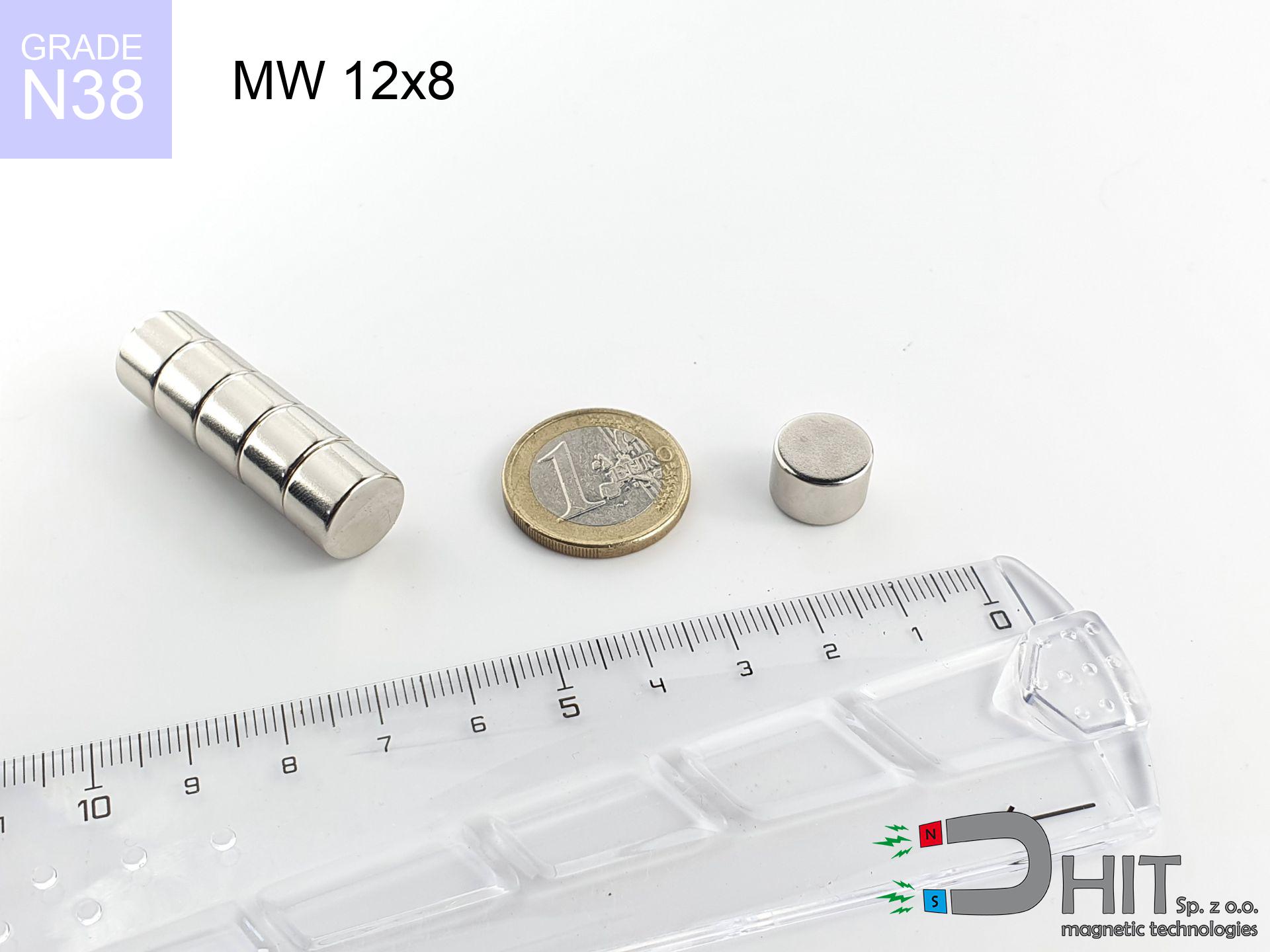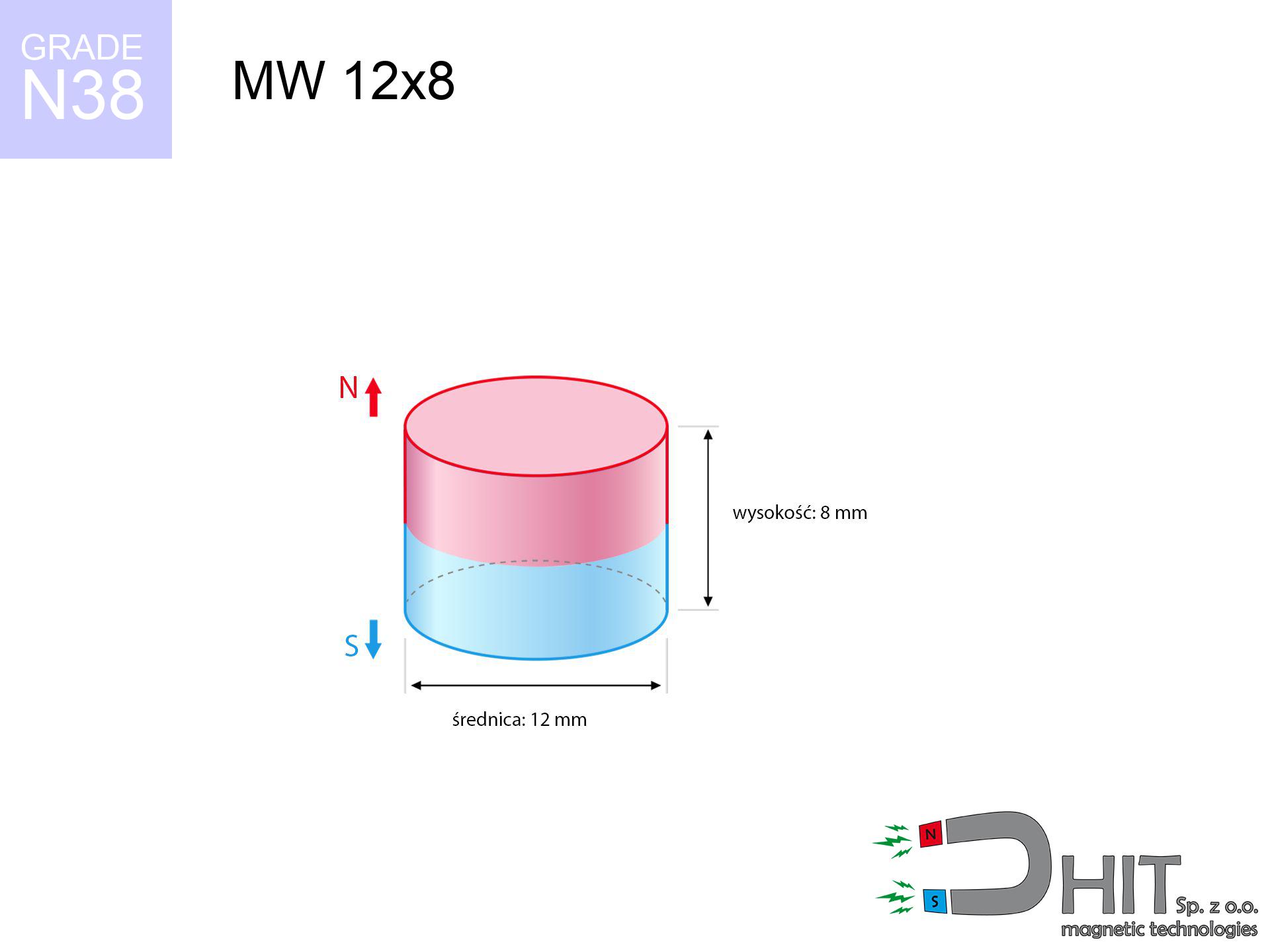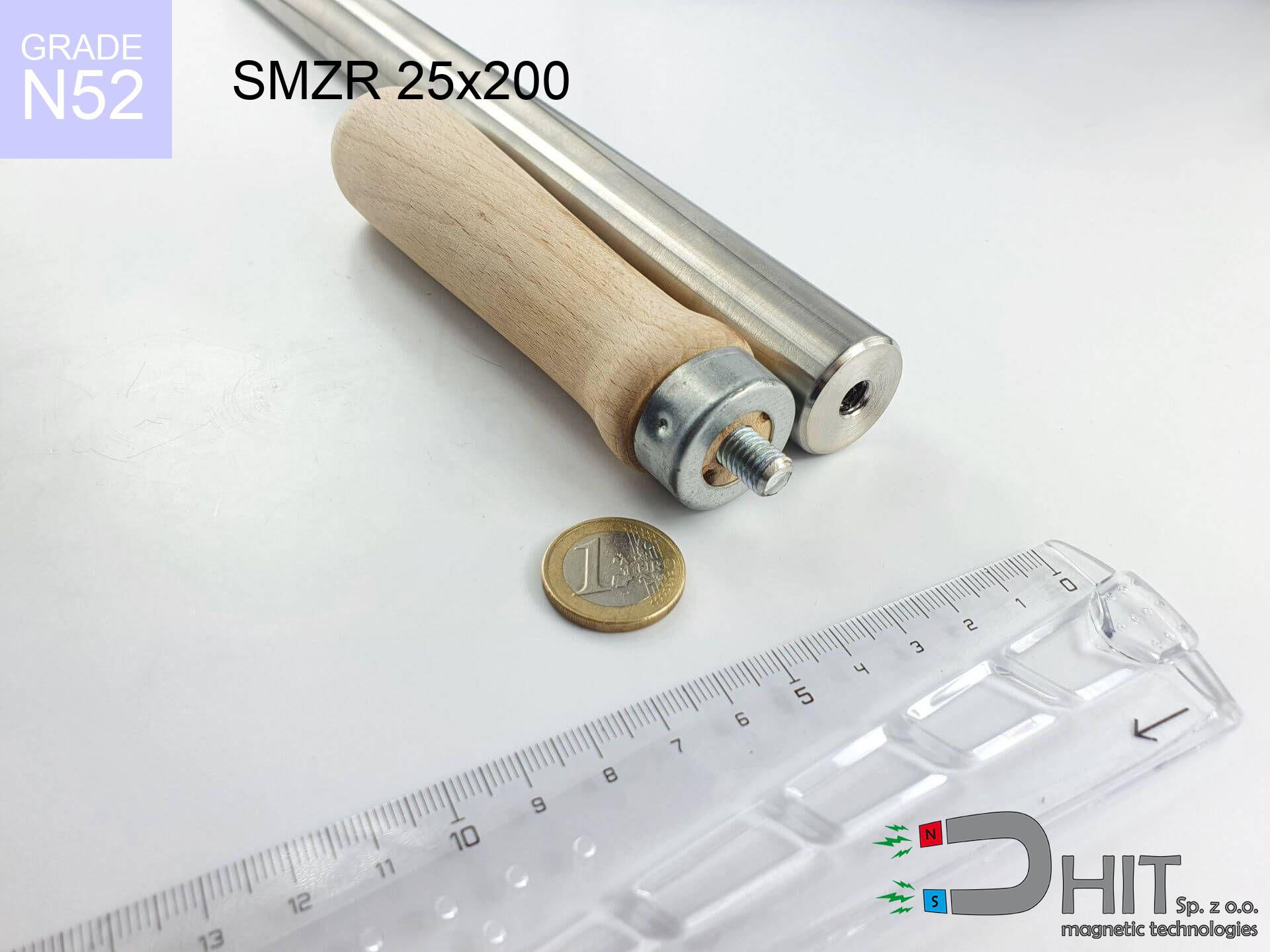MW 12x8 / N38 - cylindrical magnet
cylindrical magnet
Catalog no 010022
GTIN/EAN: 5906301810216
Diameter Ø
12 mm [±0,1 mm]
Height
8 mm [±0,1 mm]
Weight
6.79 g
Magnetization Direction
↑ axial
Load capacity
4.93 kg / 48.32 N
Magnetic Induction
495.50 mT / 4955 Gs
Coating
[NiCuNi] Nickel
2.47 ZŁ with VAT / pcs + price for transport
2.01 ZŁ net + 23% VAT / pcs
bulk discounts:
Need more?Can't decide what to choose?
Give us a call
+48 888 99 98 98
otherwise contact us by means of
inquiry form
through our site.
Specifications and shape of magnetic components can be checked using our
online calculation tool.
Same-day shipping for orders placed before 14:00.
MW 12x8 / N38 - cylindrical magnet
Specification / characteristics MW 12x8 / N38 - cylindrical magnet
| properties | values |
|---|---|
| Cat. no. | 010022 |
| GTIN/EAN | 5906301810216 |
| Production/Distribution | Dhit sp. z o.o. |
| Country of origin | Poland / China / Germany |
| Customs code | 85059029 |
| Diameter Ø | 12 mm [±0,1 mm] |
| Height | 8 mm [±0,1 mm] |
| Weight | 6.79 g |
| Magnetization Direction | ↑ axial |
| Load capacity ~ ? | 4.93 kg / 48.32 N |
| Magnetic Induction ~ ? | 495.50 mT / 4955 Gs |
| Coating | [NiCuNi] Nickel |
| Manufacturing Tolerance | ±0.1 mm |
Magnetic properties of material N38
| properties | values | units |
|---|---|---|
| remenance Br [min. - max.] ? | 12.2-12.6 | kGs |
| remenance Br [min. - max.] ? | 1220-1260 | mT |
| coercivity bHc ? | 10.8-11.5 | kOe |
| coercivity bHc ? | 860-915 | kA/m |
| actual internal force iHc | ≥ 12 | kOe |
| actual internal force iHc | ≥ 955 | kA/m |
| energy density [min. - max.] ? | 36-38 | BH max MGOe |
| energy density [min. - max.] ? | 287-303 | BH max KJ/m |
| max. temperature ? | ≤ 80 | °C |
Physical properties of sintered neodymium magnets Nd2Fe14B at 20°C
| properties | values | units |
|---|---|---|
| Vickers hardness | ≥550 | Hv |
| Density | ≥7.4 | g/cm3 |
| Curie Temperature TC | 312 - 380 | °C |
| Curie Temperature TF | 593 - 716 | °F |
| Specific resistance | 150 | μΩ⋅cm |
| Bending strength | 250 | MPa |
| Compressive strength | 1000~1100 | MPa |
| Thermal expansion parallel (∥) to orientation (M) | (3-4) x 10-6 | °C-1 |
| Thermal expansion perpendicular (⊥) to orientation (M) | -(1-3) x 10-6 | °C-1 |
| Young's modulus | 1.7 x 104 | kg/mm² |
Physical simulation of the magnet - technical parameters
These values are the direct effect of a engineering simulation. Results rely on algorithms for the material Nd2Fe14B. Operational performance may differ from theoretical values. Use these data as a supplementary guide for designers.
MW 12x8 / N38
| Distance (mm) | Induction (Gauss) / mT | Pull Force (kg) | Risk Status |
|---|---|---|---|
| 0 mm |
4952 Gs
495.2 mT
|
4.93 kg / 4930.0 g
48.4 N
|
strong |
| 1 mm |
4139 Gs
413.9 mT
|
3.44 kg / 3445.0 g
33.8 N
|
strong |
| 2 mm |
3356 Gs
335.6 mT
|
2.26 kg / 2264.2 g
22.2 N
|
strong |
| 3 mm |
2670 Gs
267.0 mT
|
1.43 kg / 1433.5 g
14.1 N
|
weak grip |
| 5 mm |
1660 Gs
166.0 mT
|
0.55 kg / 554.1 g
5.4 N
|
weak grip |
| 10 mm |
565 Gs
56.5 mT
|
0.06 kg / 64.3 g
0.6 N
|
weak grip |
| 15 mm |
243 Gs
24.3 mT
|
0.01 kg / 11.8 g
0.1 N
|
weak grip |
| 20 mm |
124 Gs
12.4 mT
|
0.00 kg / 3.1 g
0.0 N
|
weak grip |
| 30 mm |
45 Gs
4.5 mT
|
0.00 kg / 0.4 g
0.0 N
|
weak grip |
| 50 mm |
11 Gs
1.1 mT
|
0.00 kg / 0.0 g
0.0 N
|
weak grip |
MW 12x8 / N38
| Distance (mm) | Friction coefficient | Pull Force (kg) |
|---|---|---|
| 0 mm | Stal (~0.2) |
0.99 kg / 986.0 g
9.7 N
|
| 1 mm | Stal (~0.2) |
0.69 kg / 688.0 g
6.7 N
|
| 2 mm | Stal (~0.2) |
0.45 kg / 452.0 g
4.4 N
|
| 3 mm | Stal (~0.2) |
0.29 kg / 286.0 g
2.8 N
|
| 5 mm | Stal (~0.2) |
0.11 kg / 110.0 g
1.1 N
|
| 10 mm | Stal (~0.2) |
0.01 kg / 12.0 g
0.1 N
|
| 15 mm | Stal (~0.2) |
0.00 kg / 2.0 g
0.0 N
|
| 20 mm | Stal (~0.2) |
0.00 kg / 0.0 g
0.0 N
|
| 30 mm | Stal (~0.2) |
0.00 kg / 0.0 g
0.0 N
|
| 50 mm | Stal (~0.2) |
0.00 kg / 0.0 g
0.0 N
|
MW 12x8 / N38
| Surface type | Friction coefficient / % Mocy | Max load (kg) |
|---|---|---|
| Raw steel |
µ = 0.3
30% Nominalnej Siły
|
1.48 kg / 1479.0 g
14.5 N
|
| Painted steel (standard) |
µ = 0.2
20% Nominalnej Siły
|
0.99 kg / 986.0 g
9.7 N
|
| Oily/slippery steel |
µ = 0.1
10% Nominalnej Siły
|
0.49 kg / 493.0 g
4.8 N
|
| Magnet with anti-slip rubber |
µ = 0.5
50% Nominalnej Siły
|
2.47 kg / 2465.0 g
24.2 N
|
MW 12x8 / N38
| Steel thickness (mm) | % power | Real pull force (kg) |
|---|---|---|
| 0.5 mm |
|
0.49 kg / 493.0 g
4.8 N
|
| 1 mm |
|
1.23 kg / 1232.5 g
12.1 N
|
| 2 mm |
|
2.47 kg / 2465.0 g
24.2 N
|
| 5 mm |
|
4.93 kg / 4930.0 g
48.4 N
|
| 10 mm |
|
4.93 kg / 4930.0 g
48.4 N
|
MW 12x8 / N38
| Ambient temp. (°C) | Power loss | Remaining pull | Status |
|---|---|---|---|
| 20 °C | 0.0% |
4.93 kg / 4930.0 g
48.4 N
|
OK |
| 40 °C | -2.2% |
4.82 kg / 4821.5 g
47.3 N
|
OK |
| 60 °C | -4.4% |
4.71 kg / 4713.1 g
46.2 N
|
OK |
| 80 °C | -6.6% |
4.60 kg / 4604.6 g
45.2 N
|
|
| 100 °C | -28.8% |
3.51 kg / 3510.2 g
34.4 N
|
MW 12x8 / N38
| Gap (mm) | Attraction (kg) (N-S) | Repulsion (kg) (N-N) |
|---|---|---|
| 0 mm |
17.10 kg / 17097 g
167.7 N
5 795 Gs
|
N/A |
| 1 mm |
14.44 kg / 14437 g
141.6 N
9 101 Gs
|
12.99 kg / 12993 g
127.5 N
~0 Gs
|
| 2 mm |
11.95 kg / 11947 g
117.2 N
8 279 Gs
|
10.75 kg / 10753 g
105.5 N
~0 Gs
|
| 3 mm |
9.74 kg / 9744 g
95.6 N
7 477 Gs
|
8.77 kg / 8770 g
86.0 N
~0 Gs
|
| 5 mm |
6.27 kg / 6269 g
61.5 N
5 997 Gs
|
5.64 kg / 5642 g
55.3 N
~0 Gs
|
| 10 mm |
1.92 kg / 1922 g
18.9 N
3 320 Gs
|
1.73 kg / 1730 g
17.0 N
~0 Gs
|
| 20 mm |
0.22 kg / 223 g
2.2 N
1 131 Gs
|
0.20 kg / 201 g
2.0 N
~0 Gs
|
| 50 mm |
0.00 kg / 4 g
0.0 N
142 Gs
|
0.00 kg / 0 g
0.0 N
~0 Gs
|
MW 12x8 / N38
| Object / Device | Limit (Gauss) / mT | Safe distance |
|---|---|---|
| Pacemaker | 5 Gs (0.5 mT) | 7.0 cm |
| Hearing aid | 10 Gs (1.0 mT) | 5.5 cm |
| Timepiece | 20 Gs (2.0 mT) | 4.5 cm |
| Mobile device | 40 Gs (4.0 mT) | 3.5 cm |
| Remote | 50 Gs (5.0 mT) | 3.0 cm |
| Payment card | 400 Gs (40.0 mT) | 1.5 cm |
| HDD hard drive | 600 Gs (60.0 mT) | 1.0 cm |
MW 12x8 / N38
| Start from (mm) | Speed (km/h) | Energy (J) | Predicted outcome |
|---|---|---|---|
| 10 mm |
27.40 km/h
(7.61 m/s)
|
0.20 J | |
| 30 mm |
47.07 km/h
(13.08 m/s)
|
0.58 J | |
| 50 mm |
60.77 km/h
(16.88 m/s)
|
0.97 J | |
| 100 mm |
85.94 km/h
(23.87 m/s)
|
1.93 J |
MW 12x8 / N38
| Technical parameter | Value / Description |
|---|---|
| Coating type | [NiCuNi] Nickel |
| Layer structure | Nickel - Copper - Nickel |
| Layer thickness | 10-20 µm |
| Salt spray test (SST) ? | 24 h |
| Recommended environment | Indoors only (dry) |
MW 12x8 / N38
| Parameter | Value | SI Unit / Description |
|---|---|---|
| Magnetic Flux | 5 650 Mx | 56.5 µWb |
| Pc Coefficient | 0.71 | High (Stable) |
MW 12x8 / N38
| Environment | Effective steel pull | Effect |
|---|---|---|
| Air (land) | 4.93 kg | Standard |
| Water (riverbed) |
5.64 kg
(+0.71 kg Buoyancy gain)
|
+14.5% |
1. Vertical hold
*Caution: On a vertical surface, the magnet holds only approx. 20-30% of its max power.
2. Steel saturation
*Thin steel (e.g. 0.5mm PC case) drastically limits the holding force.
3. Heat tolerance
*For N38 grade, the critical limit is 80°C.
4. Demagnetization curve and operating point (B-H)
chart generated for the permeance coefficient Pc (Permeance Coefficient) = 0.71
This simulation demonstrates the magnetic stability of the selected magnet under specific geometric conditions. The solid red line represents the demagnetization curve (material potential), while the dashed blue line is the load line based on the magnet's geometry. The Pc (Permeance Coefficient), also known as the load line slope, is a dimensionless value that describes the relationship between the magnet's shape and its magnetic stability. The intersection of these two lines (the black dot) is the operating point — it determines the actual magnetic flux density generated by the magnet in this specific configuration. A higher Pc value means the magnet is more 'slender' (tall relative to its area), resulting in a higher operating point and better resistance to irreversible demagnetization caused by external fields or temperature. A value of 0.42 is relatively low (typical for flat magnets), meaning the operating point is closer to the 'knee' of the curve — caution is advised when operating at temperatures near the maximum limit to avoid strength loss.
Material specification
| iron (Fe) | 64% – 68% |
| neodymium (Nd) | 29% – 32% |
| boron (B) | 1.1% – 1.2% |
| dysprosium (Dy) | 0.5% – 2.0% |
| coating (Ni-Cu-Ni) | < 0.05% |
Environmental data
| recyclability (EoL) | 100% |
| recycled raw materials | ~10% (pre-cons) |
| carbon footprint | low / zredukowany |
| waste code (EWC) | 16 02 16 |
View also offers
Advantages as well as disadvantages of Nd2Fe14B magnets.
Strengths
- Their strength is durable, and after approximately ten years it drops only by ~1% (theoretically),
- They are noted for resistance to demagnetization induced by external disturbances,
- Thanks to the shimmering finish, the plating of nickel, gold, or silver-plated gives an visually attractive appearance,
- They show high magnetic induction at the operating surface, making them more effective,
- Made from properly selected components, these magnets show impressive resistance to high heat, enabling them to function (depending on their shape) at temperatures up to 230°C and above...
- Thanks to versatility in shaping and the ability to modify to specific needs,
- Fundamental importance in electronics industry – they serve a role in mass storage devices, brushless drives, advanced medical instruments, as well as other advanced devices.
- Relatively small size with high pulling force – neodymium magnets offer strong magnetic field in compact dimensions, which allows their use in compact constructions
Disadvantages
- To avoid cracks under impact, we recommend using special steel housings. Such a solution secures the magnet and simultaneously increases its durability.
- NdFeB magnets lose strength when exposed to high temperatures. After reaching 80°C, many of them experience permanent weakening of strength (a factor is the shape as well as dimensions of the magnet). We offer magnets specially adapted to work at temperatures up to 230°C marked [AH], which are very resistant to heat
- Due to the susceptibility of magnets to corrosion in a humid environment, we suggest using waterproof magnets made of rubber, plastic or other material stable to moisture, in case of application outdoors
- Limited ability of producing nuts in the magnet and complicated shapes - preferred is a housing - magnet mounting.
- Health risk to health – tiny shards of magnets can be dangerous, in case of ingestion, which gains importance in the aspect of protecting the youngest. It is also worth noting that small components of these devices are able to be problematic in diagnostics medical when they are in the body.
- High unit price – neodymium magnets cost more than other types of magnets (e.g. ferrite), which hinders application in large quantities
Pull force analysis
Best holding force of the magnet in ideal parameters – what contributes to it?
- using a sheet made of mild steel, functioning as a ideal flux conductor
- possessing a massiveness of at least 10 mm to ensure full flux closure
- characterized by smoothness
- under conditions of no distance (surface-to-surface)
- for force applied at a right angle (in the magnet axis)
- in neutral thermal conditions
Determinants of lifting force in real conditions
- Distance – the presence of any layer (paint, tape, air) acts as an insulator, which lowers capacity steeply (even by 50% at 0.5 mm).
- Pull-off angle – note that the magnet holds strongest perpendicularly. Under shear forces, the holding force drops drastically, often to levels of 20-30% of the nominal value.
- Metal thickness – thin material does not allow full use of the magnet. Magnetic flux penetrates through instead of converting into lifting capacity.
- Steel grade – the best choice is pure iron steel. Stainless steels may attract less.
- Base smoothness – the more even the plate, the larger the contact zone and stronger the hold. Roughness creates an air distance.
- Heat – neodymium magnets have a sensitivity to temperature. At higher temperatures they are weaker, and at low temperatures they can be stronger (up to a certain limit).
Lifting capacity was measured with the use of a smooth steel plate of suitable thickness (min. 20 mm), under vertically applied force, in contrast under attempts to slide the magnet the holding force is lower. Moreover, even a slight gap between the magnet and the plate lowers the holding force.
Health Danger
For implant holders: Strong magnetic fields disrupt medical devices. Keep minimum 30 cm distance or ask another person to work with the magnets.
Sensitization to coating
Certain individuals experience a contact allergy to nickel, which is the standard coating for NdFeB magnets. Extended handling can result in skin redness. We recommend use safety gloves.
Keep away from computers
Powerful magnetic fields can destroy records on payment cards, hard drives, and other magnetic media. Stay away of at least 10 cm.
Respect the power
Before use, read the rules. Sudden snapping can destroy the magnet or injure your hand. Be predictive.
Crushing force
Large magnets can smash fingers instantly. Under no circumstances put your hand between two attracting surfaces.
Swallowing risk
Strictly store magnets away from children. Ingestion danger is high, and the consequences of magnets connecting inside the body are life-threatening.
Dust is flammable
Dust produced during cutting of magnets is self-igniting. Do not drill into magnets without proper cooling and knowledge.
Power loss in heat
Monitor thermal conditions. Exposing the magnet above 80 degrees Celsius will permanently weaken its properties and strength.
Beware of splinters
Neodymium magnets are sintered ceramics, which means they are fragile like glass. Collision of two magnets leads to them shattering into small pieces.
GPS Danger
GPS units and mobile phones are extremely susceptible to magnetism. Direct contact with a powerful NdFeB magnet can decalibrate the internal compass in your phone.





![SM 25x300 [2xM8] / N42 - magnetic separator SM 25x300 [2xM8] / N42 - magnetic separator](https://cdn3.dhit.pl/graphics/products/sm-25x300-2xm8-kud.jpg)
![SM 25x325 [2xM8] / N52 - magnetic separator SM 25x325 [2xM8] / N52 - magnetic separator](https://cdn3.dhit.pl/graphics/products/sm-25x325-2xm8-bit.jpg)


